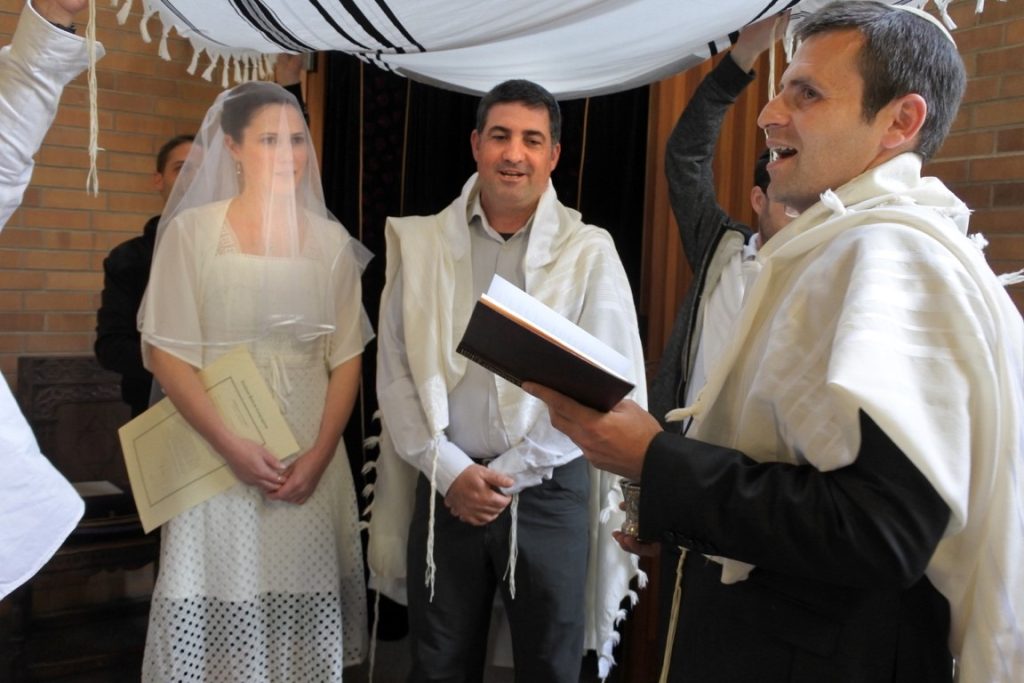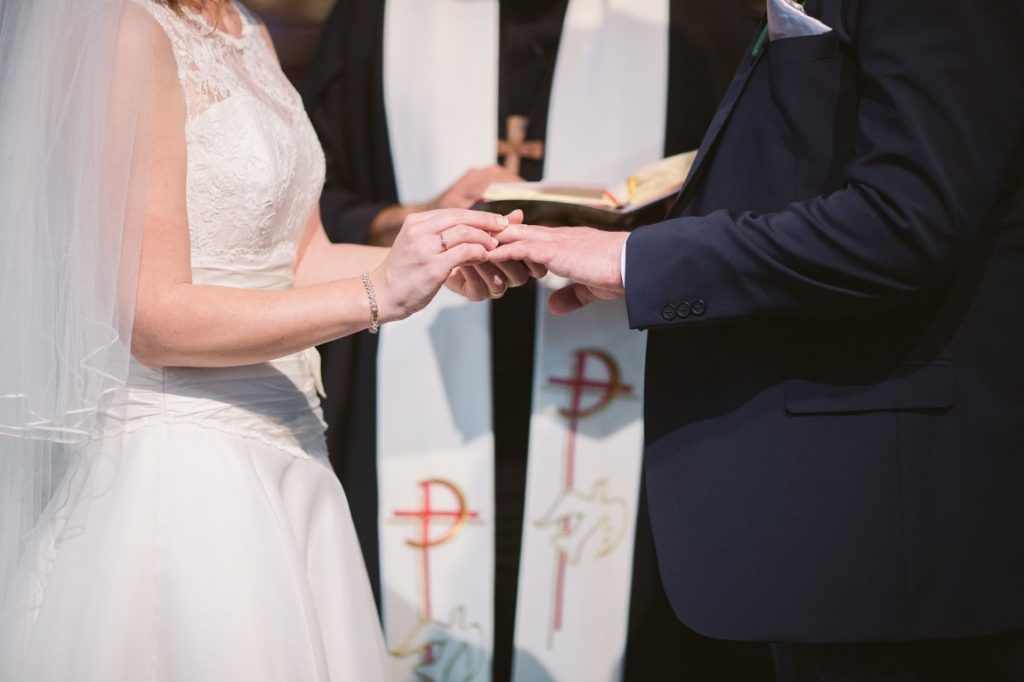Every individual is different and unique. We are born with distinct circumstances, grow up with diverse upbringings, and navigate society with various worldviews. Religion is one of the primary sources of our differences, as it informs most aspects of our lives.
However, these differences do not have to set us apart. For instance, interfaith weddings are allowed by many religions. Below are two Jewish Catholic wedding ceremony samples to give you an idea of how interfaith ceremonies go.
Jewish Catholic Wedding Ceremony Samples

1. The processional starts.
The Rabbi gives opening remarks.
Rabbi: Welcome, everyone. (Name of partner) and (name of partner) are delighted to see many of their loved ones here today to share their love and celebrate their relationship.
The Rabbi blesses the guests.
Rabbi: May (Name of partner) and (name of partner)’s friends, family, and loved ones be blessed with peace, good health, and fortune.
May the universe’s truths and values guide, inspire, and instill peace within you and your kin.
[Shehecheyanu] Blessed are You, Adonai, our God, Sovereign of all, who has kept us alive, sustained us, and brought us to this season.
The Rabbi recognizes the Couple’s Interfaith Union.
Rabbi: As you all know, our lovely bride and groom come from two different faiths. (Name of partner) was born and raised Catholic, while (name of partner) was born and raised Jewish.
Despite this difference, they found each other. They show that differences should not push us away from each other; rather, when we learn to appreciate the uniqueness each individual has to offer, something beautiful comes out of it: love.
This marriage will be solemnized under a chuppah, which, in Jewish belief, symbolizes a new home. Afterward, the couple will perform The Cord of Three Strands, a Catholic unity ceremony that represents two people coming together in a faithful marriage.
The priest gives opening remarks.
Priest: It is an honor and a privilege to witness the union of (name of partner) and (name of partner) and to officiate the wedding with (name of Rabbi).
Before we proceed, let us take a moment to close our eyes, pray, and spend some time in silence to remember the loved ones of (name of partner) who cannot be with us here today. Even so, their thoughts and prayers are with the couple.
The priest and Rabbi recite marriage blessings.
The Rabbi proceeds with the blessing over the wine, a Jewish tradition.
Rabbi: This cup of wine has two meanings. Firstly, this wine represents the sweetness we pray for in your future. Not every variety of wine will be sweet — some are bitter, dark, dry, or sour. However, always remember to cherish the sweetness, the goods, and the ups when you come across them.
Secondly, this cup of wine represents the act and value of sharing. You have shared a lot of time leading up to this union, which entails sharing many experiences, feelings, and hardships.
As you take a sip from this cup of wine, let it symbolize your promise to be there for each other, to be resilient, and to lean on each other through everything.
Thanks be to you, Oh God, the Creator of the fruit of the vine.
Chosen guests — friends or relatives — stand up to read some readings.
The priest facilitates the declaration of intent, consent, and the exchange of vows.
Priest: (Name of partner), in front of your loved ones, do you proclaim your love and commitment to (name of partner), choosing them as your life partner? Do you offer yourself to them as they offer their self to you?
Partner 1: I do.
Priest: (Name of partner), in front of your loved ones, do you proclaim your love and commitment to (name of partner), choosing them as your life partner? Do you offer your full self to them, as they offer their full self to you?
Partner 2: I do.
If the couple wrote additional vows, they can share them at this point.
The Rabbi facilitates the exchange of rings.
Rabbi: Throughout history, wedding rings have represented lifelong love and commitment to your partner. Like a circle, your love knows no start or end. May this ring symbolize your unending faith, tenderness, and love for one another.
(Name of partner), as you put the ring on (name of partner)’s finger, repeat after me:
(Name of partner), I give you this ring
As my best friend, soulmate, and partner
Just as this ring has no end
I will be there for you now and forever.
Repeat for the other partner.
The priest facilitates The Cord of Three Strands.
The Seven Wedding Blessings are said here.
The Rabbi proceeds with the pronouncement.
Rabbi: (Name of partner) and (name of partner), everyone here today is elated to share your happiness. May today mark the start of an auspicious, blessed, and healthy life, one that is full of love, happiness, and kindness.
By the power vested in us, and the passion and resolution with which you performed your rites, we declare you partners in life.
The Rabbi and priest say a closing prayer to mark the end of the Christian ceremony.
The Rabbi formally ends the ceremony with the breaking of the glass.
To mark the end of this joyful occasion, we invite the newlyweds for the breaking of the glass. This tradition can mean different things to different couples, but for (names of partners), this symbolizes the ups and downs they know their future holds.
As they break the glass, they vow to stand by each other through the difficulties life has in store. Their commitment to each other makes them stronger and more resilient.
Everyone, once the glass has been broken, let us all cheer “Mazel Tov!” This means “Congratulations!” or “Good luck!” in Hebrew.
Mazel Tov!

2. The priest greets the congregation, makes miscellaneous reminders for housekeeping, and says a short prayer.
The Rabbi and priest take turns in giving opening remarks.
The priest facilitates the sign of peace, followed by a short prayer of gratitude.
Priest: Peace be with you.
Everyone: And also with your spirit.
Priest: Let us pray to the Lord. Dear God, we praise and give thanks to You for Your wisdom, grace, and kindness. We recognize that it is Your perfect plan that has brought (name of partner) and (name of partner) together at the right time and right place.
We express our heartfelt gratitude to You for giving our lovely couple wonderful parents who raised them to be resourceful, compassionate, and God-fearing individuals.
May You guide all of us to be a loving and supportive community that will hold ourselves accountable for the promises we make to You. For this, we pray, Amen.
Everyone: Amen.
The priest says a short prayer of remembrance for loved ones who could not attend the ceremony.
The Rabbi performs the blessing of the chuppah after explaining the canopy’s symbolism and significance.
Rabbi: Baruch Atah Adonai, Eloheinu Melech Haolam, Mi-Kah Deish Amo Yisrael, Al Yiday Chuppah V’ki Du-Shin.
Blessed are you, Lord, King of the universe, you sanctify your people under this sacred marriage canopy.
The chosen readings will be read here.
The priest will give a Homily based on the readings.
If you want, the Ketubah — a Jewish marriage contract — can be read to formally start the rite of marriage.
The priest will facilitate the declaration of intent and exchange of vows.
If you wrote personal vows, say them here.
The Seven Blessings can be read in their entirety here. However, you can shorten this part of the ceremony by only going with the seventh blessing.
The Rabbi facilitates the blessing over the wine.
The Rabbi or priest gives a blessing and facilitates the ring exchange.
If you want to incorporate a unity ceremony, such as a candle or sand ceremony, it can go here.
The priest may give a nuptial blessing.
The conclusion begins with the Priestly Blessing. The Rabbi can recite in Hebrew, followed by English translations from the priest.
Priest: In this spirit, we ask God to shower you with blessings.
Rabbi: Y’varech’cha Adonai v’yishm’recha
Priest: May the Lord bless you and keep you,
Rabbi: Ya’eir Adonai panav eilecha vichunecha
Priest: May the Lord’s countenance shine upon you and be gracious unto you.
Rabbi: Yisa Adonai panav eilecha v’yaseim l’cha shalom.
Priest: May the Lord lift His face up to you and give you peace.
The priest and Rabbi can proceed with the pronouncement and the breaking of the glass to end the ceremony.
Priest: Go in peace to love and serve the Lord.
Everyone: Thanks be to God.
Final Thoughts
The outlines of Jewish Catholic wedding ceremony samples presented above are only examples; you and your partner have ultimate control over what happens on your special day. Feel free to work with your officiants to figure out what is best for you.